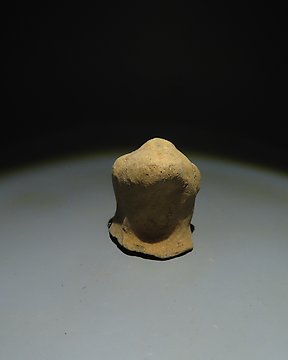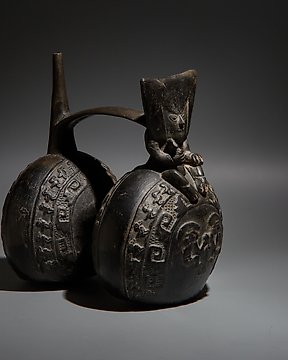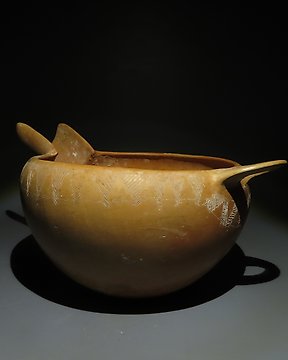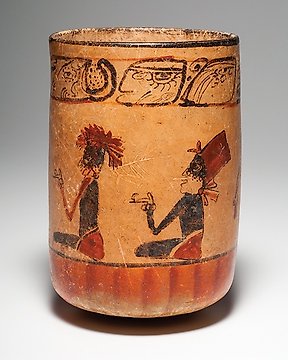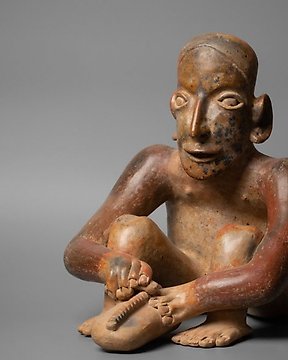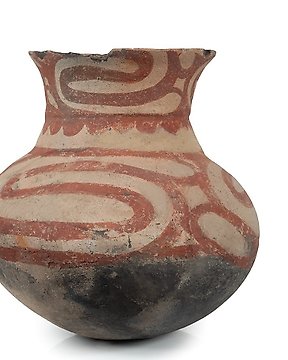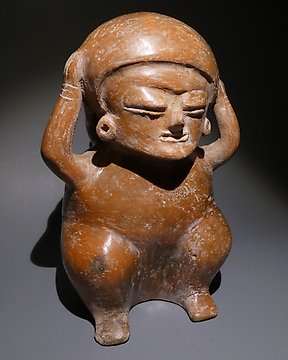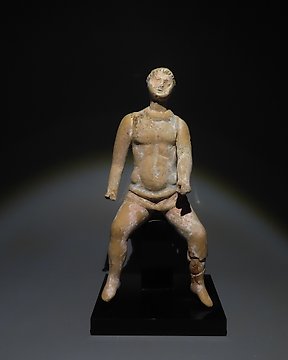Perfecto! :)
Se oversettelseZapoteca, Mexico Terrakotta Representasjon av kornguden. 300-500 e.Kr. 21 cm. Spansk importlisens.
Nr. 85410669
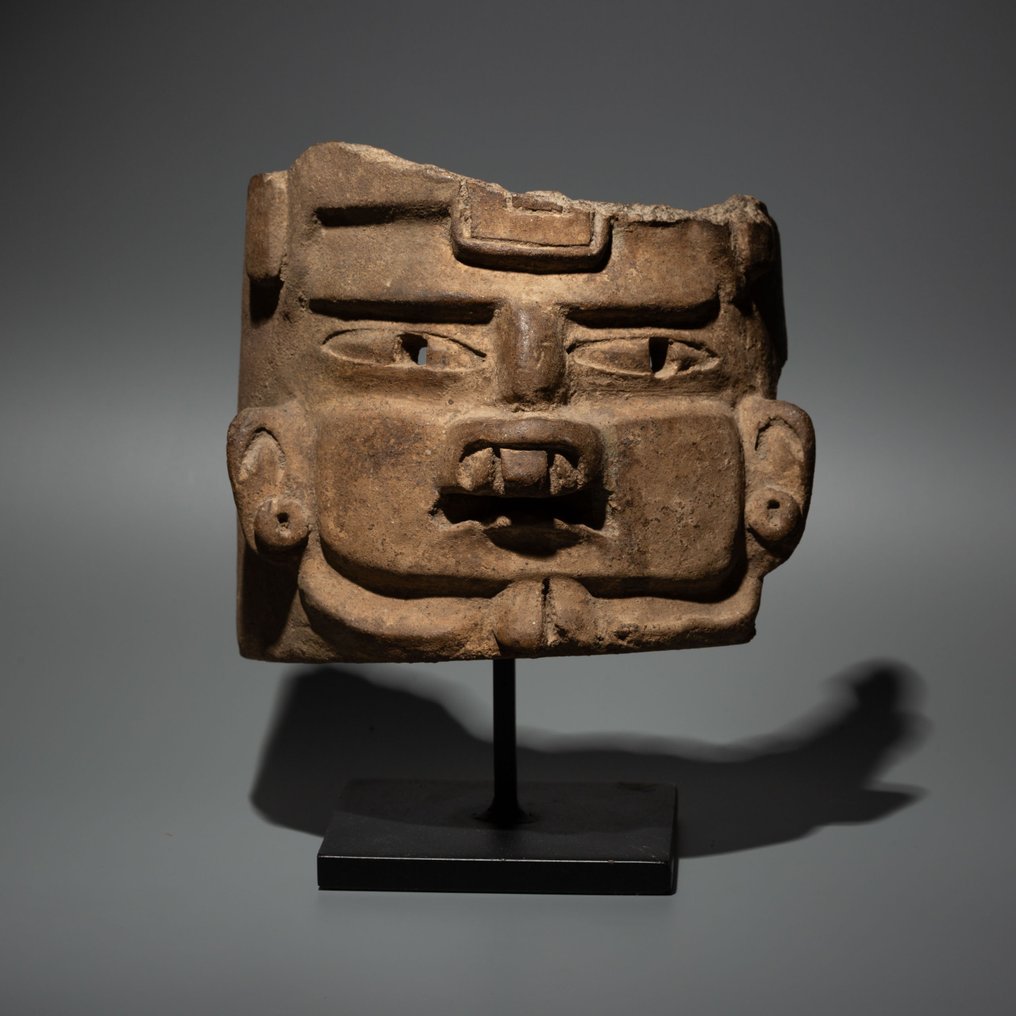

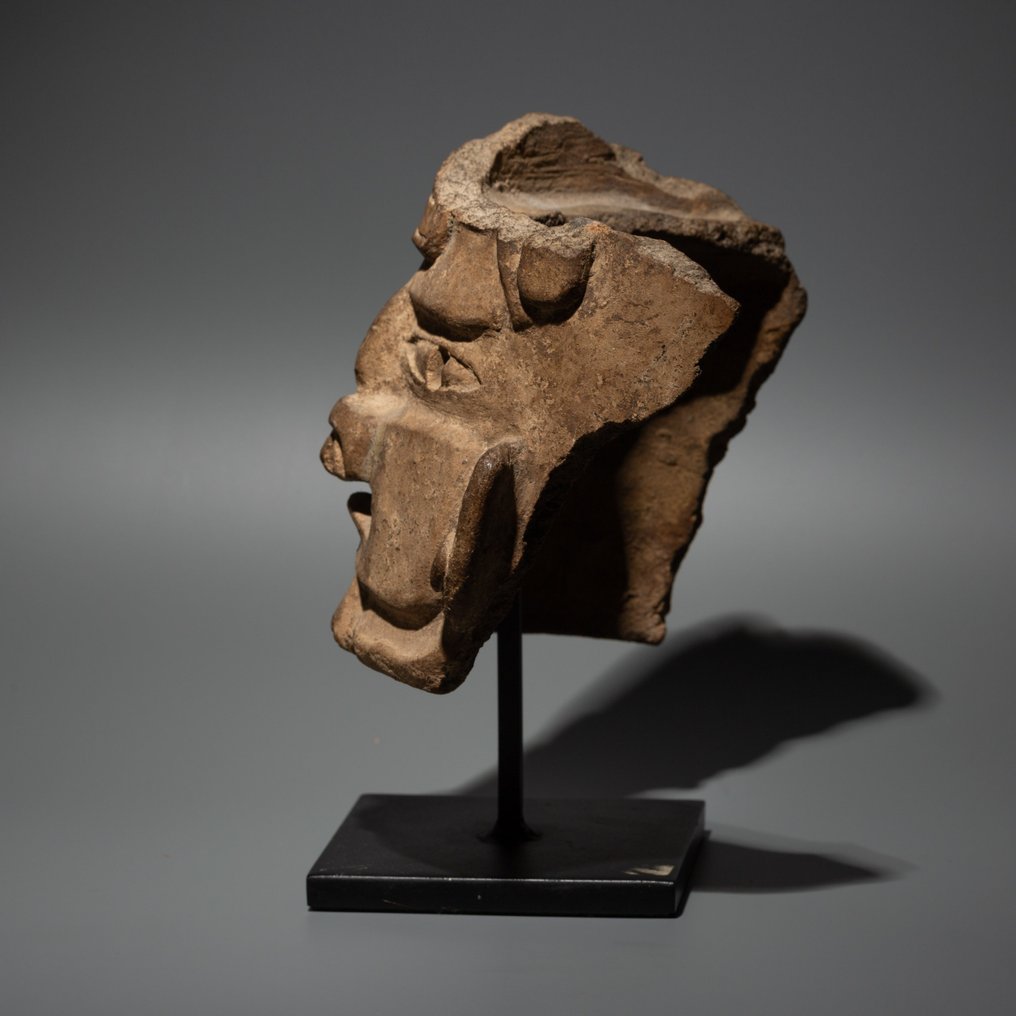
Representation of the god of corn, in which they warn a Cinerary urn front
Zapoteca, Mexico.
300-500 AD.
Terracotta
17.5 cm Height
PROVENANCE: Smaller Bay Mask - Cano Gallery, Quito, Ecuador, November 7, 1980. Romy Rey Collection, London.
CONDITION: Good Condition.
DESCRIPTION:
The Zapotec culture arose in the Central Valleys of what is now the State of Oaxaca, Mexico, 500 BC – 150 AD. Oaxaca is a predominantly mountainous area with a variety of ecosystems that range from high mountain temperate forests to lowland tropical rainforests.
The Zapotecs were mainly an agricultural people. Their sophisticated irrigation system enabled them to produce large quantities of food, with maize as a staple crop. Perhaps their most significant achievement was the development of a writing system, which remained in use for over a thousand years in Mesoamerica. Only certain classes were literate, but Zapotec writings have been found on a wide variety of materials including bone, seashell, ceramic, and stone. It is believed that they also wrote on perishable materials such as wood, cotton textiles, paper, and animal skins. The Zapotec writing system consists of glyphs that describe historic events and dates, and was probably used by the ruling classes to record their deeds and keep accounts of goods and labor. It was also used to tell stories of wars and battles.
The Zapotecs are celebrated for their stoneworking skill, especially the decorative designs that appear often in their architecture. Their bas-reliefs and wall paintings constitute some of the most valuable expressions of pre-Hispanic art in Mexico. Particularly noteworthy are the images of warriors and captives, which reflects the importance of war in Zapotec culture. Also of note are the designs known as “dancers”, which depict individuals in scenes of sacrifice and submission. The architecture of the late Zapotec period features more elaborate decoration of mosaics, carved slabs, and friezes.
The society was highly stratified, with a governing class that probably ruled with a theocratic model. This elite maintained power through a system of alliances and marriages with local authorities in the territory under the group’s influence.
Beneath the nobility were traders and specialized craftsmen, while the large peasant class formed the base of the social pyramid.
Usually, this culture buried their dead nearby, beneath the floor of their dwellings or close by. These were simple burials and did not involve any kind of construction. Some graves, however, do include complex constructions: doorways covered with bas-reliefs, vestibules, burial chambers, and polychrome wall paintings. Highly detailed bas-relief representations of players of the Mesoamerican ball game, which carried great ritual and symbolic significance for the Zapotecs, shared space with images of priests, offerings, and jaguars – an animal that played a central role in all Mesoamerican religions. Sacrifices seem to have played an important role in religious life also, given the large number of bas-reliefs showing people either in their death throes or already sacrificed. The gallery of the “Dancers” at Monte Albán is a example of such artwork.
The earliest Zapotec villages were built on the banks of rivers, in locations suitable for growing maize. Each consisted of about 10 dwellings around which daily activities were carried out. The culture’s main urban center was Monte Albán, strategically located on a terraced mountain plain overlooking the surrounding valley. This center grew rapidly and monumentally to a radius of 4km around the central plaza. It had two courts for playing the Mesoamerican ball game as well as several other imposing structures. Residents’ dwellings were located on the sides of the mountain, away from the central complex. Zapotec homes consisted of a dwelling with a small garden, a well for storing water, and spaces for craft workshops.
Many decorative elements found in the central plaza at Monte Albán show clear influences from the Teotihuacán culture. Mixtec artifacts and offerings also have been found in some buildings, suggesting possible contact and religious links between these two cultures. Around 800 AD, Monte Albán began to decline as the Zapotecs came into increasing contact with the Mayan civilization. Internal strife brought about the collapse of the culture around 1300 AD.
Notes:
The seller guarantees that he acquired this piece according to all national and international laws related to the ownership of cultural property. Provenance statement seen by Catawiki.
The seller will take care that any necessary permits, like an export license will be arranged, he will inform the buyer about the status of it if this takes more than a few days.
The piece includes authenticity certificate.
The piece includes Spanish Export License.
Historien til selger
Representation of the god of corn, in which they warn a Cinerary urn front
Zapoteca, Mexico.
300-500 AD.
Terracotta
17.5 cm Height
PROVENANCE: Smaller Bay Mask - Cano Gallery, Quito, Ecuador, November 7, 1980. Romy Rey Collection, London.
CONDITION: Good Condition.
DESCRIPTION:
The Zapotec culture arose in the Central Valleys of what is now the State of Oaxaca, Mexico, 500 BC – 150 AD. Oaxaca is a predominantly mountainous area with a variety of ecosystems that range from high mountain temperate forests to lowland tropical rainforests.
The Zapotecs were mainly an agricultural people. Their sophisticated irrigation system enabled them to produce large quantities of food, with maize as a staple crop. Perhaps their most significant achievement was the development of a writing system, which remained in use for over a thousand years in Mesoamerica. Only certain classes were literate, but Zapotec writings have been found on a wide variety of materials including bone, seashell, ceramic, and stone. It is believed that they also wrote on perishable materials such as wood, cotton textiles, paper, and animal skins. The Zapotec writing system consists of glyphs that describe historic events and dates, and was probably used by the ruling classes to record their deeds and keep accounts of goods and labor. It was also used to tell stories of wars and battles.
The Zapotecs are celebrated for their stoneworking skill, especially the decorative designs that appear often in their architecture. Their bas-reliefs and wall paintings constitute some of the most valuable expressions of pre-Hispanic art in Mexico. Particularly noteworthy are the images of warriors and captives, which reflects the importance of war in Zapotec culture. Also of note are the designs known as “dancers”, which depict individuals in scenes of sacrifice and submission. The architecture of the late Zapotec period features more elaborate decoration of mosaics, carved slabs, and friezes.
The society was highly stratified, with a governing class that probably ruled with a theocratic model. This elite maintained power through a system of alliances and marriages with local authorities in the territory under the group’s influence.
Beneath the nobility were traders and specialized craftsmen, while the large peasant class formed the base of the social pyramid.
Usually, this culture buried their dead nearby, beneath the floor of their dwellings or close by. These were simple burials and did not involve any kind of construction. Some graves, however, do include complex constructions: doorways covered with bas-reliefs, vestibules, burial chambers, and polychrome wall paintings. Highly detailed bas-relief representations of players of the Mesoamerican ball game, which carried great ritual and symbolic significance for the Zapotecs, shared space with images of priests, offerings, and jaguars – an animal that played a central role in all Mesoamerican religions. Sacrifices seem to have played an important role in religious life also, given the large number of bas-reliefs showing people either in their death throes or already sacrificed. The gallery of the “Dancers” at Monte Albán is a example of such artwork.
The earliest Zapotec villages were built on the banks of rivers, in locations suitable for growing maize. Each consisted of about 10 dwellings around which daily activities were carried out. The culture’s main urban center was Monte Albán, strategically located on a terraced mountain plain overlooking the surrounding valley. This center grew rapidly and monumentally to a radius of 4km around the central plaza. It had two courts for playing the Mesoamerican ball game as well as several other imposing structures. Residents’ dwellings were located on the sides of the mountain, away from the central complex. Zapotec homes consisted of a dwelling with a small garden, a well for storing water, and spaces for craft workshops.
Many decorative elements found in the central plaza at Monte Albán show clear influences from the Teotihuacán culture. Mixtec artifacts and offerings also have been found in some buildings, suggesting possible contact and religious links between these two cultures. Around 800 AD, Monte Albán began to decline as the Zapotecs came into increasing contact with the Mayan civilization. Internal strife brought about the collapse of the culture around 1300 AD.
Notes:
The seller guarantees that he acquired this piece according to all national and international laws related to the ownership of cultural property. Provenance statement seen by Catawiki.
The seller will take care that any necessary permits, like an export license will be arranged, he will inform the buyer about the status of it if this takes more than a few days.
The piece includes authenticity certificate.
The piece includes Spanish Export License.
Historien til selger
- 748
- 7
- 0
Wunderbares Stück. Alles wie beschrieben. Hervorragender Kontakt.
Se oversettelseExtremely rapid courrier service from Barcelona to Flanders, picture was nicely and carefully packaged. Muchas gracias!
Se oversettelseVery fine specimen! Thanks.
Se oversettelsegoede foto's, goede omschrijving, goed verpakt en snel verzonden.
Se oversettelsemolto bello tutto ok
Se oversettelsePezzo come da descrizione, davvero notevole. Venditore molto consigliato in quanto gentile e disponibile. spedizione molto veloce. Ottimo!
Se oversettelseVenditore davvero ottimo e gentile. Merce come da descrizione, spedizione veloce. Ottimo l'avere certificato di autenticità.
Se oversettelseUn 100 como empresa un 100 como envío . Empresa muy especial con mucha exquisitez en todos los productos y en personal . Muchas gracias
Se oversettelseAll well! Thanks.
Se oversettelseVery nice and fine cut little jewel! Well packed too! Thanks!
Se oversettelsenice piece and very fast shipping!
Se oversettelseEs una maravilla de moneda, donde se le nota los pasos de los años y me encanta. Servido muy rápido y bien empaquetado. Con su certificación. Qué más se puede pedir?
Se oversettelseSnelle en correcte levering, alleen was de verpakking voor het schilderij niet stevig genoeg.
Se oversettelseHerzlichen Dank!
Se oversettelseAll OK and with very fast shipping.
Se oversettelsePrachtig schilderij. Zo blij mee. Zeer nette verkoper en zeer snelle levering.
Se oversettelseperfect ! very fast and high quality delivery !
Se oversettelseAll well! Thanks.
Se oversettelseVendeur très professionnel, top +++×
Se oversettelsePhotos trop contrastées pour bien percevoir les défauts, mais ces défauts étaient visibles pour autant. Le "Bon état" est trompeur. Sinon, envoi rapide et correctement emballé. Frais de port exagérés.
Se oversettelseGreat communication, delivery and product. Came with a well made certificate of authenticity and good packaging. Overall very happy with the purchase! Delivery is a bit expensive, but I recommend it
Se oversettelseMagnifique témoin du passé, envoyé avec tous les justificatifs, impeccable. Encore une fois très satisfait, un grand merci
Se oversettelseThank you for the Special offer and the fast shipping of this excellent piece of art!
Se oversettelseForbehold
Selger garanterer og kan bevise at objektet ble lovlig skaffet. Selger ble informert av Catawiki at de måtte skaffe dokumentasjonen som er påkrevd av lover og regler i deres bostedsland. Selger garanterer og har rett til å selge/eksportere dette objektet. Selger må skaffe all herkomst informasjon som er kjent for objektet til kjøper. Selger forsikrer at alle nødvendige tillatelser er/vil bli skaffet. Selger vil informere kjøper umiddelbart om det er forsinkelser ved å få tak i slike tillatelser.
Selger garanterer og kan bevise at objektet ble lovlig skaffet. Selger ble informert av Catawiki at de måtte skaffe dokumentasjonen som er påkrevd av lover og regler i deres bostedsland. Selger garanterer og har rett til å selge/eksportere dette objektet. Selger må skaffe all herkomst informasjon som er kjent for objektet til kjøper. Selger forsikrer at alle nødvendige tillatelser er/vil bli skaffet. Selger vil informere kjøper umiddelbart om det er forsinkelser ved å få tak i slike tillatelser.
